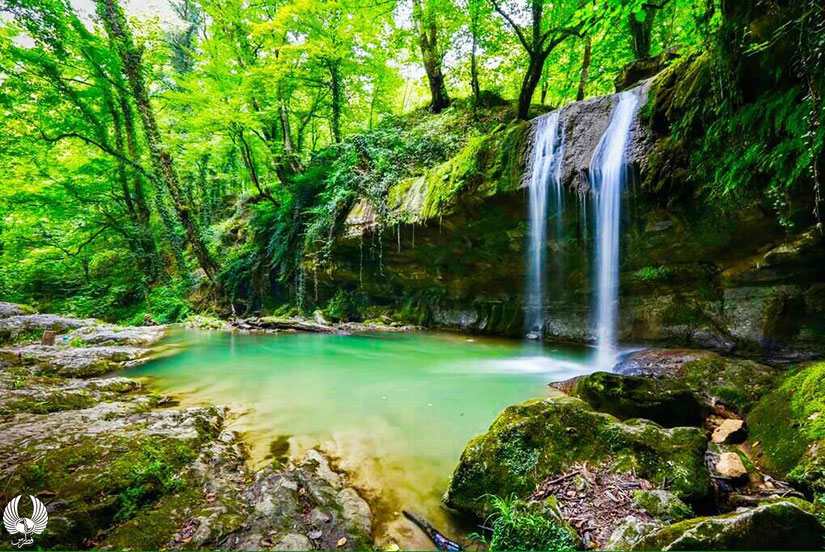
Hyrcanian Forests
Hyrcanian forests, these ancient forests are considered to be the unique forests in the world, and some call them, natural museums or living fossils. In fact, the name of Hyrcanian is the old name of Gorgan in the Mazin dialect, which is also known as Jurjan or Vorkan. It is said that the name of Vorkan is also written in the inscriptions left from the Achaemenid era. Join Fotros Travel on Iran Wildlife Tour to visit and experience this beautiful part of Iran.

The Hyrcanian forests cover a range of 800 kilometers (from Astara to East Gorgan) and the width of approximately 110 kilometers, the northern hillsides of the Alborz mountain range from the sea level to the forest line (2800 meters above sea level). The total space of this forest area is over 1.8 million hectares, accounting for 1.1 percent of Iran's land. Hyrcanian forests cover parts of the five northern border provinces of the north of Iran (from west to east: Ardebil, Gilan, Mazandaran, Golestan and northern Khorasan), and this area is now known as the "ecological zone of Caspian Hyrcanian mixed forests, which is one of the 200 world's ecological regions, sponsored by the World Wildlife Fund.

The Hyrcanian forests are left from the third era of geology and ice age and it is rich in indigenous species, vegetation and biodiversity, with the rarest forest species in the world including 150 species of benthic and endemic, and 60 species of mammals, 340 bird species, 67 Fish species, 29 reptile species and nine species of amphibians. The Mazandarani tiger (Caspian tiger) that is the largest carnivore in Iran, was extinct 20 years ago, and other species that have fallen dramatically include leopard, lynx, brown bear, wolf, jackal, forest catfish, otter and Meral. The Hyrcanian forests are also registered as the International Important Bird Area (IBA).

Forest areas of the Hyrcanian Growing Area:
The trees of these forests are a mixed type of broadleaf of the southern margin of the Caspian Sea, which are compatible with the Mediterranean climate and humidity. Hyrcanian forests have often various vegetation based on their altitudes.
Plateau areas and low altitudes (mostly oaks, Shamshadestan, Tushkistan, Tuska in Lorgestan and evangelical areas)
Moderate hillsides (mostly Anjili hornbeam, ocher hornbeam)
High hillsides (Rashestan and Rash - Hornbeam)
The areas of upper heights and forest boundaries (including the dominant species of Avery, Laura, Sarabina Cedar and Caminus).
Rash areas - the most famous and the widest area with various species of the mountainous trees of the north – Cliamaks area is a large part of the Hyrcanian forests.
From the most famous trees, can mention: beech, oak, alder, hornbeam, maple, Angili, elm, asparagus, wild cherry, Baranak, yew berry, Namdar, Shemshad, larch, lilaki, khormandi, Azad, figs and so forth. The shrubs of these forests are also known as Azgils, hawthorns, blueberries, wild plums, pomegranates, Jell, Khas, KulE Khas, wild apples and etc.

Animal species in Hyrcanian forests:
1. Birds:
Sparrows, woodpeckers, broad tip ducks in the autumn of Hyrcanian forests, extincting Caspian Pheasant, Partridge, Quails, Forest Pigeons, sparrow-hawk, Royal falcon, falcon, Dal (vulture), Eagle, Owl, Saw duck (Gray duck or Marmary duck). Miankaleh Wetland is a best place for birder and birdwatchers to see many birds. To ease the way for birders, Fotros travel with its professional birdwatching guides help you to visit birds in Iran. Join Miankaleh Wetland Birdwatching tour to see birds in Golestan province.
2. Mammals and Livestock:
Meral, Shoka, Kol and goat are in the most extinct parts except from Golestan National Park and Hyrcanian forests in Amol, Leopard, Wolf, Hog, Brown Bear (these bears are feathered by brown color and they have weak eyes but, a strong sense of smelling and keen hearing, black fox (special in Hyrcanian forests), jackal, sable, hedgehog, porcupine, rabbit, forest rat, badger and wild cat live in Hyrcanian forests. Hyrcanian forests and wildlife are the home of these animals and the Caspian horses are also discovered in Hyrcanian forests.

UNESCO Registration
The 40-million-year-old Hyrcanian forests located in both Iran and Azerbaijan were introduced to Azerbaijan in December 2006 for registration at UNESCO. According to UNESCO experts, because of the 20,000-hectare share of the Republic of Azerbaijan against their 2-million-hectare share, their request was denied. But, finally, the it was issued as the second natural place on Iran UNESCO World Heritage Site in July 2019. 15 parts of these forests include Golestan National Park, Shahroud Forest Park, Jahan Nama Protected Area, Bula Protected Area, Alimastan Forest, Waz Forest, Kajour Nooshahr Area, Four Gardens in Chalous, Khoshke Daran Gardens, Gasht Rudkhan Protected Area and Black Mazghi, Siah Roodbar in Gilan and Lisar Protected Area are the sites to be listed on the World Heritage List.
Related Tags:
We love to hear your comments